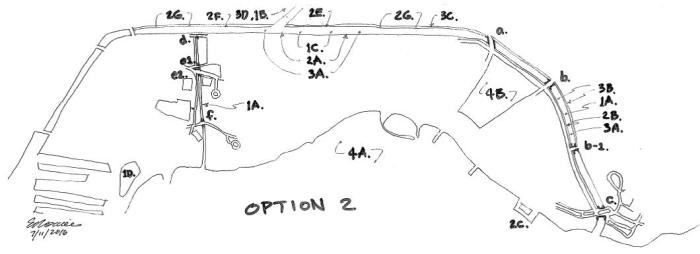Originally published July 12, 2016
This blog covers the environmental and cultural aspects of the 2016 Hybrid Re-Design proposal. Along the Ala Wai Canal, there would be lo’i kalo or taro patches and fishponds via an extensive aquaponics system. Also, culturally, there would be significant trees, plants and an arboretum.
New structures include lava rock walls, hale pilis, or traditional ancient Hawaiian buildings, heiau, or an ancient Hawaiian place of worship, heritage centers, and residences–all of which would provide cultural benefits.
Environmentally, there would be an agricultural extension service; new tributaries would include the management and cleanup of brackish water; and specific areas would go under conservation.
Politically and legally, this plan would be part of a jurisdiction that includes the protection of 30 miles off the shoreline. Finally, management and forest management practices would be led by the United States Park Service.

Diagram of Waikiki
Above. The 2016 Hybrid Re-Design Plan proposal – Option Two, would transform the Ala Wai Canal and Waikiki, with new tributaries and tree-lined esplanades. The proposal would provide a more culturally sensitive experience in which cultural and educational activities are in harmonious balance. The initial name Hybrid Re-Design was because the design is a hybrid of both man-made and natural solutions.
To download the PDF file of drawing, click here:
2016 Hybrid Re-Design Plan – Option 2
Cultural
Taro Patches via Aquaponics, etc.
A 200 feet wide by 2.7 mile-long segment of the Ala Wai Canal, which is marked by McCully Street on the ewa end and Noela Place on the diamond head end would be part of an extensive system of transportation via water and an extensive system of aquaponics via fish ponds and lo’i kalo or taro patches.
On the mauka side of the strip of land as mentioned above, a 50 feet wide by 2.7 mile-long strip of re-claimed land would be primarily for cultural and religious groups and those who are responsible for the taro patches. This particular strip of land would also contain a sewage facility.

Fresh and Brackish Water Clean Up and Management
Legend: 1A. New tributaries, which consist of brackish water, work hand in hand with the esplanades and would provide transition areas between the freshwater that come from the watersheds and the salt water that come from the open ocean; 1B. The Ala Wai Watershed would go under conservation; 1C. New fishponds would work in conjunction with the taro patches or lo’i kalo under an extensive aquaponic system; 1D. Existing Lagoon
New Structures
Legend: 2D. Hale Pilis or traditional ancient Hawaiian buildings — would house culturally significant activities; 2E. Heiau or an ancient Hawaiian place of worship would offer a place to honor Lono; 2F. Heritage centers would offer interactive activities and programs; 2G. Residences would house those who would be responsible for the taro patches and the fish ponds, as well as house significant religious and cultural groups.
Natural Areas to Fall Under Forest Management Practices
Legend: 3A. Lo’i kalo or taro patches would filter and clean the water from the watershed, absorb and slow down runoff, provide a way of life for those tending to the taro and offer a glimpse into the past regarding what occurred in ancient times; 3B. Culturally significant trees and plants that existed at this ahupua’a over a hundred years ago would be planted; 3C. Arboretum would house wetland types of plants; 3D. An agricultural extension service would manage the bamboo forests as part of a program that studies forest management practices.
Political and Legal
Legend: 4A – Public right of ways of Waikiki, which includes 30 miles off the shoreline would go under this plan; 4B – Existing Zoo
Street legend: a. Kapahulu Avenue; b. Monsarrat Avenue: b-1. Noela Street; c. Kalakaua Avenue and Poni Moi Road; d. Ala Wai Boulevarde; e1. Kuhio Avenue; e2. Kalakaua Avenue; f. Kalia Road; g. Ala Wai Boulevard; h. Kuhio Avenue; i. Kalakaua Avenue; j. Kalia Road
Political and Legal
The Role of the U.S. Park Service
Under this plan, the United States Park Service would serve as an umbrella organization to provide the appropriate resources to preserve and interpret the cultural activities that exist in this ahupua’a, or land division, past, and present.
Browse Further
Hopefully, from viewing this proposal, you will get excited about the cultural and environmental opportunities that would be coming to the Ala Wai Canal and Waikiki. You have gotten a glimpse into the 2016 Hybrid Re-Design Plan proposal, which eventually became the basis for the Ho’okuleana Design ©2016, 2017.
Please browse further and act!
Related Links:
~~~
Emy Louie is a consultant and the author of “Fast Trains: America’s High Speed Future.” Since 2009, Ms. Louie has served as the “Director of Public Outreach” for the “US High Speed Rail Association.” Since 2008, she has taught continuing education classes on design and urban development to architects and engineers. In 2007 and 2008, she hosted her radio show. In 1991, Emy earned a Bachelor of Architecture from the University of Hawai’i at Mānoa.
